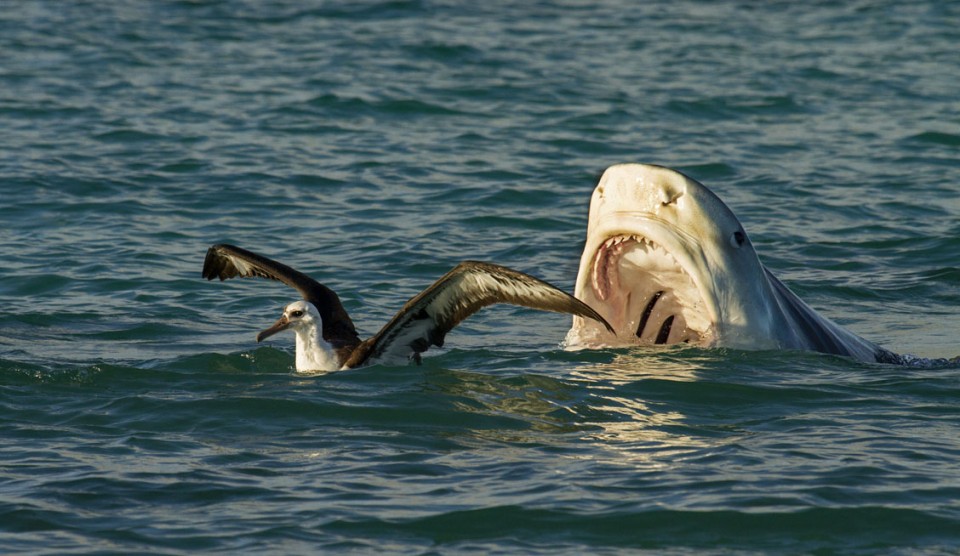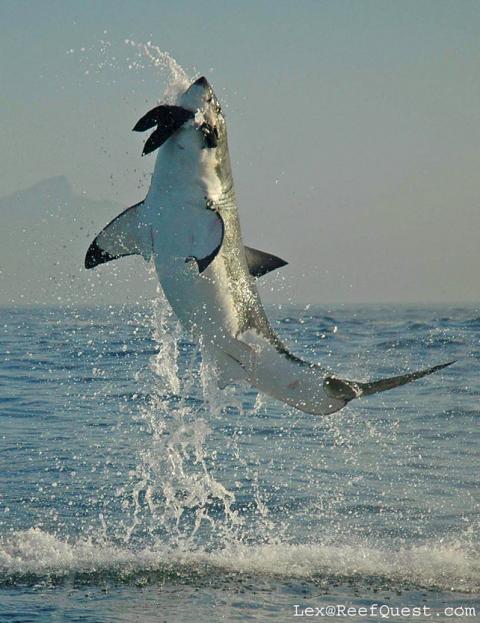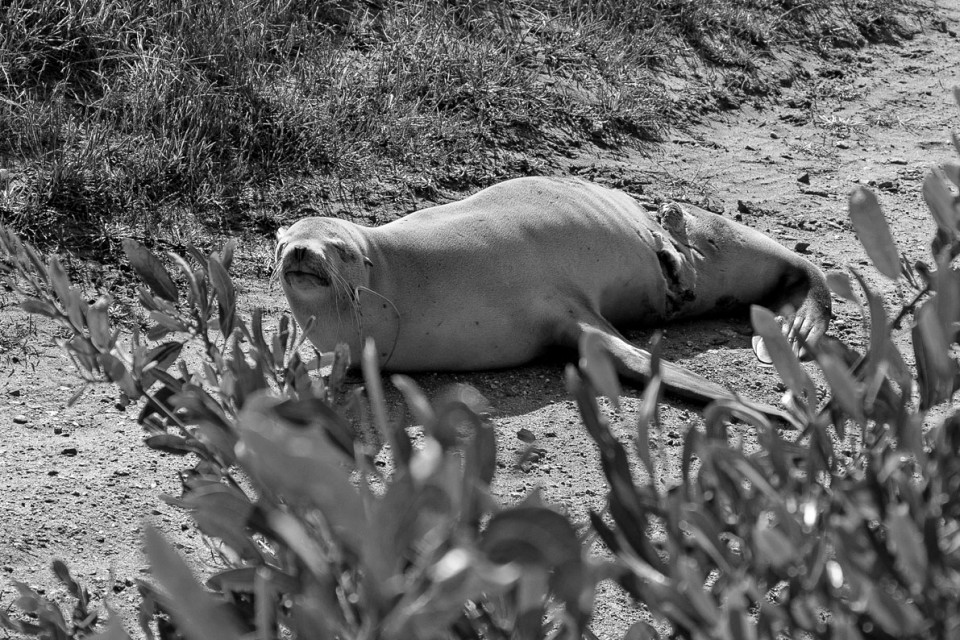Increasingly, people and sharks come into contact as humans spend their leisure time in the seas and oceans. Many people fear sharks and particularly being attacked/bitten by one, but it is important to remember that these incidents are rare. Indeed, in 2017, the International Shark Attack File (ISAF), housed at the University of Florida, received reports of 88 confirmed unprovoked attacks worldwide, five of which (~6%) were tragically fatal; but this must be viewed in the light of the billions of people entering the water every year. Overall, surfers and swimmers account for about 80% of shark attack victims and, while the number of attacks has increased (possibly a reflection of an increasing human population), for the past few decades, the fatality rate has been falling through a combination of better education and advances in medical care.
Attacking species
According to ISAF records (1580 – 2016) the top ten sharks most commonly implicated in unprovoked attacks are:
Great white shark (Carcharodon carcharias) in 314 attacks
Tiger shark (Galeocerdo cuvier) in 111 attacks
Bull shark (Carcharhinus leucas) in 100 attacks
Blacktip shark (Carcharhinus limbatus) & Sandtiger shark (Carcharias taurus) in 29 attacks
Carpet sharks (Orectolobus spp.) in 28 attacks
Hammerhead sharks (Sphyrna spp.) in 17 attacks
Spinner shark (Carcharhinus brevipinna) in 16 attacks
Bronze whaler shark (Carcharhinus brachyurus) in 15 attacks
Blue shark (Prionace glauca) in 13 attacks
It is important to note that this list does not necessarily translate to “top 10 most dangerous sharks” and, in many cases, reflects the species most likely to be found in the habitats in which humans also frequent. Shark identification is an acquired skill, particularly when it comes to separating some of the reef sharks (Carcharhinus spp.), which makes establishing the true culprit (which are seldom actually seen by the victim) a difficult process.

Even using bite wounds the wrong culprit can sometimes be implicated. In September 2007, for example, a surfer died in the waters off New Caledonia after sustaining a single bite from what was widely reported to have been a great white shark. A subsequent re-analysis of the evidence by Philippe Tirard and colleagues, published in the Journal of Forensic and Legal Medicine during 2017, suggests the culprit was actually a tiger shark. Consequently, this list must be interpreted with caution.
Types of shark attack
In his contribution to the 1990 American Littoral Society book, Discovering Sharks, curator of the ISAF George Burgess explained how shark behaviourists recognise three types of shark attack: Hit and Run; Bump and Bite; and Sneak attacks.
Hit & Run: This is the most common form of attack recorded by the ISAF. Hit and run attacks typically occur in the surf zone, with swimmers and surfers the most common target. The victim seldom sees the shark and the shark does not return after the initial contact. Injuries to hit and run victims are usually confined to relatively small lacerations, frequently on the legs, and are not usually fatal.
Bump & Bite: Characterized by the shark circling and often “bumping” their victim prior to instigation of an attack. Unfortunately, this behaviour appears to be associated with feeding and often leads to serious, often fatal, injuries. Multiple bites are not uncommon.

Sneak: Sneak attacks occur without warning and, like Bump & Bite attacks, may be associated with feeding. Multiple bites are not uncommon. Burgess suggests that many victims of aviation disasters probably suffer either Bump & Bite or Sneak attacks.
Shark attacks on seals and sea lions (collectively termed pinnipeds) are generally different to shark-human incidents, often varying according to geography and prey type. Scientists currently recognise two broad categories of attack on pinnipeds. In a 1984 contribution to the Proceedings of the California Academy of Sciences, Tim Tricas and John McCosker reported on their bite-and-spit hypothesis while, in a 1996 paper, Peter Klimley and his colleagues described an exsanguination (bloodletting) tactic used by sharks on pinnipeds.
Bite & Spit: These attacks are characterized by a forceful initial strike, often lifting the prey and shark clean out of the water. The prey is then released and the shark moves away, leaving the animal to bleed to death. Moving away may allow the prey to die without the risk that wounded animal could fight back and injure the shark. This method of attack, as inferred by Tricas and McCosker, was based on bite wounds observed on surviving pinnipeds and accounts of white sharks leaving the prey after an initial incapacitating attack.
Exsanguination (bloodletting): This attack procedure is characterized by a shark maintaining hold of a prey item following the initial bite (i.e. the shark swims with the prey in its jaws). It is suggested that the shark will continue swimming until the prey stops bleeding, after which it will surface with the prey and begin feeding. In their fascinating 1996 paper, Klimley and his co-workers noted intervals of a minute or more between an initial strike and the appearance of a seal on the surface in two-thirds of cases. They suggest that during this interval, the shark was exsanguinating the animal, before returning to the surface to feed. Further evidence in support of this theory came from observations by the authors that seals on the surface were rarely bleeding. There are, however, alternative explanations for this interval. The time underwater could equally be indicative of the shark chasing the wounded seal or carrying the carcass away from the initial striking point, perhaps to increase the time it takes competition to arrive.
During their research, Klimley and his colleagues found no evidence to support Tricas and McCosker’s ‘Bite, spit and wait’ hypothesis.
Why do sharks sometimes attack humans?
The late Professor D.H. Davies once wrote:
“Why shouldn't the shark bite us if we swim in his sea? After all, we would set upon him pretty quickly if he was in West Street.”
This may be regarded as a rather flippant statement in the face of a serious incident, but it does serve to highlight how we humans have developed a sense of superiority relative to nature – we’re the “top” species on Earth and other animals should respect that. Consequently, when other animals infringe upon these beliefs by biting us, there is often an urgent call to “do something” about it. Part of this is trying to understand what situations result in these incidents, so we can take steps to avoid them happening in future; but we must also be aware that we have no universal right to do anything. Rights are a human social construct. The universe doesn’t care that we think we should be able to swim or surf in the ocean without fear of something biting us. We do what we do; sharks do what they do. Sometimes those worlds collide, but neither species is inherently in the wrong.

Mistaken identity is frequently cited by the media to explain shark attacks on humans. It is now considered far more probable, however, that such human-shark interactions are the result of a shark’s curiosity. Considering the majority of attacks on humans are hit and run (i.e. non-predatory), it seems unlikely that the surfer, swimmer or kayaker was mistaken for a potential meal. Many ichthyologists (people who study fish) consider that, because sharks don’t have hands, they use their highly dextrous jaws and sensitive teeth and gums as a substitute. Unfortunately for us (and indeed the sharks), humans have a high density of blood vessels very close to the skin and an investigatory bite that would do little more than wound a pinniped, can have considerably more distressing results for Homo sapiens. Indeed, one square inch of human skin contains somewhere in the region of 4.5 m (15ft) of blood vessels and 78 nerves. Similarly, human skin is thinner than that of pinnipeds. Seals and sea lion have an epidermis (the thin protective layer of the skin) up to 80-times thicker than ours and directly below the epidermis is the dermis, the region containing the blood vessels.
Further credence to the “jaws as hands” theory came from a series of experiments in the Spencer Gulf off Australia, by Rocky Strong of the Cousteau Society. Strong found that, although naïve sharks showed significant preference for objects shaped like seals or sea lions, generally white sharks investigated almost every object floating on the surface, including hats and cigarette packets, irrespective of size and shape. Strong’s experiments and further work by Scott Anderson and his colleagues using plywood seal decoys suggests great whites are primarily visual predators, because the decoys had no scent, no electrical field and did not splash. In addition, many shark biologists have remarked on how white sharks are incredibly curious animals, investigating any novel items in their domain.
Rejection of victims
In 1987, Klimley proposed that a White shark may decide whether or not to keep a prey item based on its fat content – a hypothesis based on observations that sharks would seize and consume pinniped bait, but reject sheep carcasses. Later, during a 1996 investigation, Klimley et al. observed similar scenarios, with a shark seizing and releasing an immature, highly decomposed otariid (an ‘eared seal’). There are similar examples of sharks attacking and seemingly “spitting out” sea otters (Enhydra lutris) and jackass penguins (Sphensicus demersus).
As a hypothesis for sharks biting and releasing humans, as occurs in the vast majority of shark attacks, a fat-based rejection policy seems plausible – particularly when we consider that, even though between 80 and 90% of human fat is stored subcutaneously (under the skin), subcutaneous fat is meagre by comparison to most marine mammals. If you're a fit healthy adult male, for example, the subcutaneous fat on your forearm is about 1.2mm thick. Compare this to a blubber thickness of up to 7 cm (almost 3 inches) in seals, up to 15 cm (6in) in a walrus (Odobenus rosmarus) and 30 cm (1ft) in grey whales (Eschrichtius robustus). Critics of Klimley et al’s theory note, however, that this theory appears to overlook the fact that fish are the primary dietary component of Great whites at all stages of their lifecycle. Furthermore, white sharks are known to consume small prey species that seem to be of low energy value (e.g. abalone and crabs).

In the context of deciding what to eat, the Optimal Foraging Theory deals with two components of an organism's predatory strategy: energy maximization and number maximization. Predators can rarely afford to be finicky about their choice of prey and, unfortunately for Klimley's theory, data presented by Leonard Compagno and Aidan Martin suggest that white sharks lean towards number rather than energy maximization. Moreover, as Aidan Martin noted in his SHARK-L posting of 12th August 2001, pinniped blubber actually represents a relatively poor source of energy for a Great white. As Aidan explained, seal blubber is stratified and internally supported by disulphide cross-linked collagen fibres arranged in a complex and remarkably tough matrix. Consequently, although, in terms of per unit mass, fat has twice the calorific content of protein, blubber is fairly resistant to digestion and (on a calories liberated per unit time basis) doesn’t represent a particularly rich food type.
From a maximization perspective, fishes simply constitute the most consistently available prey type for a Great white and their ubiquitous presence in the diet suggests white sharks don’t think too much about fat content when hunting. Furthermore, as we’ve discussed above, an increasingly popular theory is that human victims probably aren't “rejected” in the context commonly implied; if victims are merely the unfortunate object of selachian curiosity, then predation was never the intention.
In conclusion...
Sharks are intelligent, socially complex animals. They’re not the ruthless killing machines frequently portrayed in the media. Globally we know of nearly 500 different species of sharks, at least two-thirds of which grow to less than 2m (6ft) in length and aren’t considered a threat to humans.
There’s no getting away from the fact that some shark species (like many animals) do sometimes bite, even kill, humans. If sharks were truly interested in eating humans, though, they could have a veritable smorgasbord every weekend along beaches in almost every country. Shark attacks remain rare, however, even in areas where the large shark species are afforded legal protection and particularly relative to the increasing number of people using coastal waters. Unfortunately for humans, a curious shark can be a deadly shark – blood vessels close to the skin and a fragile frame (by comparison to a pinniped) make us very prone to damage if a shark investigates us with its mouth.